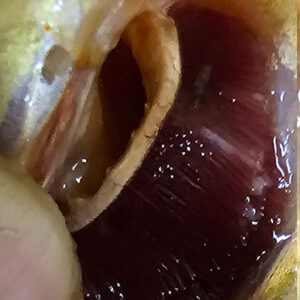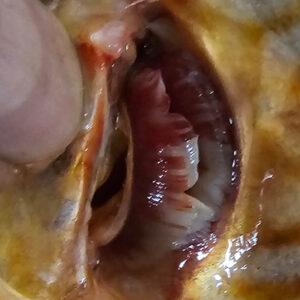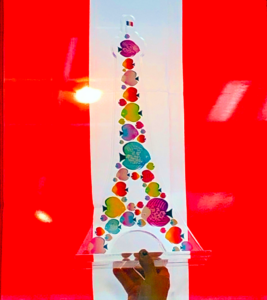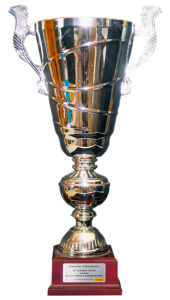FAQ
Water parameters:
PH 6 – 7,3, water hardness (total hardness) 7, carbonate hardness 1, Ms 200 – 300, temperature 28 – 30 °C
A private well supplies most of the water. 50% of this water is processed using reverse osmosis and stored in a 3000 liter storage tank (- automatic refills from there). In addiction to the stored water, during larger water changes, well water (ph 6.5; 300 Ms) is let directly into the flow filter. With every water change the water is enriched with a small amount of minerals (1 teaspoon per 1000 liters) and some humic substances (100 ml/ 1000 liters). Depending on the stocking density, 0.25 – 100% of water is changed on a weekly basis. Only for breeding purposes do we prepare the water for a short time using osmosis or mixed bed resins to 80 – 130 Ms with a PH of 5,6 to 6,5. Our experience suggests that animals that live in these conditions for a prolonged amount of time develop health problems. We assume this is due to the inherently very mineral-poor groundwater.
Water treatment:
Water is not simply water. What may work well in one case can cause fatal conditions in the aquarium of another person. If you’d like to be on the safe side, consider treating 100% of your water with an osmosis system and add minerals and micronutrients as well as vitamins to the permeate. We ourselves like to keep our wild-caught fish at higher conductivity values. This has proven itself in our case. If animals suffer from loss of appetite, it is usually due to the water or its quality.
– See also: Water parameters
Filtration
Quarantine and
Diseases
The animals are fed as often as possible. In nature, fish eat food all day and also at night.
The animals receive : 30% live food, 50% frozen food, 20% soft granules of flakes
Artificial food:
Automatic feeders dispense the best soft granulate food 5 times a day, free of any meat from warm-blooded animals. (I have tested all types of food available on the market and choose products by Waldmann exclusively for my fish these days.) (www.dein-aquaristikshop.eu)
Frozen food:
Years ago we payed to have the quality of all types of frozen food be examined. Harmful bacteria (e.g. coli) were present in almost all products. Especially the red mosquito larvae in particular were heavily contaminated.
Based on this knowledge, the animals are fed with the following:
+Discus-mix without any meat from warm-blooded animals
+White mosquito larvae (the absolute favorite)
+Mussels (as long-term food) – the remaining muscle fibers (tendons) need to be removed from the tanks daily
+Artemia – max 5% of the frozen food quantity, as, in our opinion and experience, their salt content hinders digestion in wild-caught fish and seems to be damaging.
Live food:
This is the basic form of feeding for successfully keeping wild-caught fish and breeding.
We have come to the conclusion (through long-term experiments) that without the proper nutrients and sustenance a successful and planned reproduction of wild-caught specimens is very difficult.
If live food is chosen carefully, the introduction of diseases is either impossible or very unlikely and difficult. The benefits of good quality live food far outweigh the minimal residual risk of introducing parasites.
It is also important for wild animals to be able to live out their hunting instincts and natural foraging habits. After years of observations, we are also convinced that giving live food triggers ovulation in female animals (the pituitary gland is stimulated).
Our absolute favorite amongst the „feed animals“ is a self-caught mixture of stream amphipods, mayfly larvae, stonefly larvae and microorganisms fed along from the detritus.
Furthermore, various producers and dealers offer food animals for sale.
White mosquito larvae, red cultured mosquito larvae, enchytraea, black worms and also tubifex (from good sources and rinsed and watered for a long time) are practically the essential food for our farmed fish.
Lighting:
Discus, especially wild ones, love darkness. Therefore, there should always be dark places to retreat to in planted tanks.
We ourselves installed only very weak diffused lights over our tanks. This has proven to be very effective in combination with good hiding places and deep tanks for acclimating wild animals.
In our location, we have an example of how such an aquarium can be set up and set up a 3000 liter display tank with powerful spotlights mounted centrally above the tank.
Decoration:
Beautiful, delicate root wood is considered ideal for wild-caught discus – the fish often find this in the amazon. Hanging branches or a type of bush similar to willows are also found everywhere in the amazon.
A deep tank in combination with weak lighting and plenty of hiding places are considered optimal conditions for wild-caught discus.
Aquatic plants:
If plants are to be present in the tank, the lighting must (logically) be slightly stronger than in unplanted ones.
This makes dark retreats with good hiding opportunities all the more important. We ourselves are more on the skeptical side when it comes to plants in the discus aquarium and consider them to be unnecessary and, especially in areas with softer water, a risky drain of minerals.
The filtering properties (reduction of pollutants) of plants are undoubtedly positive however.
In our display aquariums we have all our plants in pots – there is no substrate in them. This means we are able to rinse the plants to remove debris and dead parts and therefore get rid of them from the tank without problems.
Quarantine, Health, Medication:
The wild catches (excretions, swabs, etc.) are microscopically examined to determine their health and any parasites present are specifically treated in a targeted manner. Treatments are carried out using the most modern procedures and after having been discussed and developed in cooperation with the best specialist veterinarians. There are no long-term treatments but only very short, targeted medications.
In particular, the treatment of worms in the digestive tract, especially the capillaries, places a heavy burden on the fish, its internal organs (liver, spleen, kidneys) and gills when using conventional methods.
Very often, the animals become permanently damaged by too high dosages of various medications and end up dying after six to twelve months from the long-term effects of this.
However, if the worms are not actually eradicated, the fish suffer from the parasites that deprive them of nutrients, minerals and micronutrients.
Therefore, only wild-caught animals that are free of such pests are sold.
– Which medications are administered?
Please understand that we can not and will not answer this question! – we are not veterinarians and do not provide any information about any medical treatment for fish.
Please leave this to specialist veterinarians and seek their advice.
CK-Diskus consulted and developed our quarantine system with the best veterinarians so prophylactic treatments (with the exception of deworming) are completely eliminated.
Diseases:
To start: we offer our customers a free inspection of the freshly separated excrement from fish purchased from us.
For this purpose, the animals’ excretions must be caught with a net after they have been released by the fish – the excrement must not reach the aquarium floor! The collected items must then be sent to us refrigerated and by express delivery. If customers are knowledgeable enough and able to take swabs of the fish’ skin or gills, the same applies to these samples.
– Please do not carry out any tests or experiments on animals!
It’s better to leave this to an expert!
The worst „disease“: Necrosis
This topic has been thoroughly researched, especially for aquacultures (edible fish production). Our experience in breeding, rearing and producing organic edible fish is incorporated into the following short and easily understandable report.

This still gets seldomly reported on however and aquarists can hardly read up on or inform themselves about it.
The reason for this: no-one earns anything with treating it – on the contrary!
That’s why we’re devoting ourselves to this topic in detail here:
Basics-the gill:
The total area of the gills is 10 – 60 times the surface area of a fish’s skin (depending on the species and habitat) and the blood vessels in the gills lie very close to the surface of the lamellae. This enables an optimal exchange of oxygen and nitrogen. But the gills are not exclusively needed for breathing, they also serve as blood purifiers (kidney like function) and can excrete toxins from the fish.
Gill trap:
The gill trap is an organ system made up of toothed extensions of the gill arches that serves to separate food and breathing water from each other.
By opening the mouth and spreading the gill covers, the volume of the gill space increases, a negative pressure is created in the mouth and gill cavity and water is sucked in. The gill membranes seal the gill gaps. When the gill covers close, the mouth also closes and the gill space becomes smaller – the oxygen-rich water flows around the gills and is expelled through the gill slits. On the outer edge (inside) of the operculum there is a skin which seals the gill operculum during inhalation and opens the passage when exhaling (membrane effect) – when a fish is healthy, this skin cannot be seen!
How does necrosis occur and what is it?
The amount of toxins in the blood of fish increases, especially as a result of water pollution (stress). This mainly occurs during long-term transport or due to unfavorable conditions (high protein concentration in the water, rot, etc.) in the aquarium. The fish suffer from stress and try to excrete the toxins through their kidneys, liver and also their gills. An expert can immediately recognize such situations by the increased breathing of the animals.
Ideally, the fish breathe up to a maximum of 60 times per minute – the slower the better. A rate of 80 or more breaths is called emergency breathing. If other negative reasons (oxygen content, temperature) can be ruled out as a cause, only primary infections or poor
environmental conditions can be seen as responsible.
Prophylactic treatments without an exact diagnosis must be avoided as much as possible!
CK-Diskus expressly warns against such measures!
If your situation requires it, have the animals examined by a specialist. This is the only way you can proceed correctly and help your fish.
If other illnesses can be ruled out, stress (poor living conditions) is (almost always) the reason for increased breathing.
You might also want to check the lighting. Lights that are too bright can often be a cause of stress which causes damages to the discus in the long term.
If the negative factors are not reduced, the fish suffer from constant stress and, above all, from increased toxins in their body. This might appear to be working out somewhat okay over a certain amount of time. –
– But sooner or later the situation will worsen. Very often the breathing increases again and the membranous membranes on the gill covers protrude. The gill leaflets themselves are already damaged at this stage, usually swollen and covered in mucus. Secondary bacterial infections can be detected, the gills (gill skin) are permanently damaged and can no longer be repaired. Most of the time, by this point, the animals are eating poorly or not at all, the colors are fading and the animals are somewhat emaciated and skittish.
This kind of situation must definitely be improved upon before it gets to this point at the latest!
Actions to take:
+Change the water with good, pure, pre-filtered water
+Improve filtration
+Complete removal of the substrate or thorough cleaning of the substrate
+Clean water plants and, ideally, put them in pots
+Remove decomposing materials (wood, plants, etc) from the tank
+Change the kind of food you use and use it sparingly – live food does not rot!
+Separate the sick fish and treat them with salt (dialysis, mucus solution). (see acclimatization) Sick animals can stay in darkened separation tanks (transport crates) for up to 1 week.
+Such salt treatments can also be carried out in aquariums.
For this purpose, the tank should be cleared out completely (as with all treatments). +Be sure to also remove the substrate and plants from the tanks.
+Ventilate the tanks well and feed very sparingly.
+Consult a professional.
In conclusion, we at CK-Diskus want to note that environmental and husbandry conditions are almost always responsible for the illnesses in wild-caught animals. Wild-caught fish are incredibly robust against parasites; especially against gill worms.
In our 40 years of experience, we have never been able to find any mass proliferation of gill worms on our wild catches.
Examinations of individual animals from our facility, carried out by the University of Vienna, often showed no evidence of gill worms.
For this reason, it makes sense to first think about necrotic diseases before using medication for prophylactic treatment „against unknown“ of your animals.
If necrotic manifestations are not successfully treated, they inevitably lead to death of this in your care.
In the final stage of necrotic gill diseases, the gill leaflets die, become putrid (bacteria, fungi are secondary) and serious growths or ulcers may appear.
The innards (liver, spleen, kidneys) almost completely stop functioning and show a gray-brown color. The abdominal cavity is usually filled with water and often swollen.
In the past, such symptoms, especially brownish-gray livers, are attributed to fatty degeneration caused by incorrect feeding habits.
Christian Kubitschka carried out microscopic examinations of various fish by various Austrian breeders already around 35 years ago.
In addition to very resistant protozoa, fatal conditions of the innards were almost always found, attributable to massive use of medication.
Bacterial and virological infections:
The Nr.1 illness that, in our opinion, along with necrotic symptoms, account for 80% of all illnesses.
+Are mostly secondary.
+For safe treatment, we recommend consulting a specialist veterinarian.
+Please do not trust advice from unverified internet „sources“ or remote diagnoses and be cautious of veterinarians recommending their own products or products of companies they may be in a business relationship with. (In our opinion, there may be pure profiteering behind this.)
We therefore always recommend that you contact independent veterinarians or turn to any specialist universities in your area.
+Swabs, antibiograms and the resulting actions (antibiotics and precise treatment plans) lead to success and health.
In this way, you save your animals from unnecessary suffering and avoid the possible development of resistance to various bacterial strains.
+You should not dispose of the, with antibiotics contaminated, water through the normal sewer system.
+Please filter the water thoroughly over carbon (as with all medications used) beforehand.
The first course of action for us in the case of skin cloudiness, fin rot: a salt bath; see below instructions or under „necrosis“
Shipping of fish:
From the start, we would like to make clear that we have no interest in any discussion from buyers regarding the amount of water that may or may not be required, its treatment and the shipping technology. Many interested parties demand for cheaper shipping rates and would therefore prefer to have the animals sent to them with less water than we’d customarily use.
We calculate with a 48 to 55 (two full days) delivery time within Europe. For this reason we do not deviate from the amount calculated – this has already proven to be the right decision several times. The shipping boxes are adapted to the seasons and therefore 5cm transport boxes including heat packs are during the cold months – this does obviously increase the shipping cost somewhat considerably; but the well-being of the fish should matter to every animal friend and costumer.
The following amounts of water, specially prepared for shipping, are used:
For animals up to 10cm 1 liter
15cm. 2,5 liters
15 + cm. 3,5 liters
The fish are placed in their own quarantine tanks 7 days before shipment and feeding is stopped 4 days before shipment.
Acclimatization after shipping:
When the fish first arrive, put them in the styrofoam box they come in; additionally use just as much water as was supplied for transport.
2,5 g of unionized salt per liter of water.
Ventilate well and thoroughly and keep the temperature at around 25 degrees Celsius.
After about 30 minutes, change 50% of the water and keep adding more water from the aquarium they are going to be in + salt (like before)
After about another 30 minutes, add another 2 g of salt/ liter of water (total amount). After another 30 minutes, add the fish to the tank.
The box should be covered at all times. The fish can become very bright at first. Only stop the treatment if the fish start breathing quickly and tip to the side.
Please do not use any medications or other preparations for disinfection!
For acclimatization to the aquarium, you may add humic substances to the aquarium water.
The animals have been brought into contact with all sorts of possible strains of bacteria.




